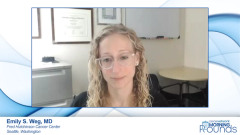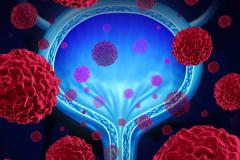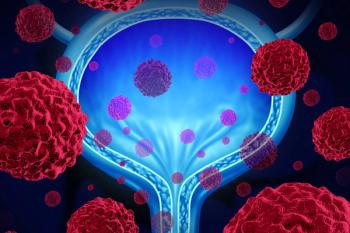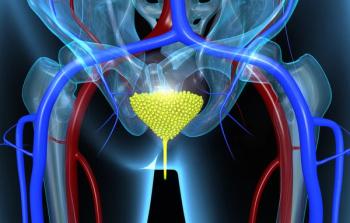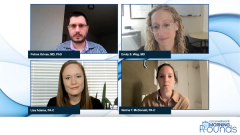
Bladder Cancer: Treatment Options for Patients With a Partial Response
Following a patient with bladder cancer who had a partial response to frontline therapy, panelists consider the branching treatment pathway.
Episodes in this series

Transcript:
Petros Grivas, MD, PhD: At the end of the treatment induction, let’s say, Emily, that patient opts to get carboplatin gemcitabine, and they get a great response to treatment. Then the patient comes to us after 3 cycles, has a partial response…treatment decides to continue, and let’s say the patient has a fantastic response after 6 cycles. Would you offer this patient a consolidation of chemoradiation at that point? Would you think about radical cystectomy or even maintenance avelumab? These are practical questions we deal with every week.
Emily S. Weg, MD: Yeah, I think I would offer—I would consider chemoradiation, I would certainly discuss it with the patient, and let them know that it’s a reasonable road to consider. One thing we haven’t talked about is this patient’s baseline urinary function. But if he were doing well overall, then I do think chemoradiation to the bladder and the pelvic lymph nodes would be reasonable to consider at this point, given his excellent response to induction chemotherapy.
Petros Grivas, MD, PhD: That’s a great question. So if someone, let’s say, gets carbo [carboplatin] gem [gemcitabine] in that case, or other patients may get gem [gemcitabine] cis [cisplatin] if they’re fit vs cisplatin, we have this question in clinic: Do we do the same chemotherapy, do we keep giving cisplatin if they can tolerate [it], or do we give gemcitabine? This is obviously case-by-case. But it sounds like from the radiation standpoint, you may customize the parameters you discussed before based on the disease. Are those parameters based on the initial disease burden or based on the staging burden? How do you go about that decision-making?
Emily S. Weg, MD: I think that’s something we are learning. We are continuing to explore and understand, but what we typically do as a strategy for radiation oncology, generally speaking…is treat to the initial extent of disease. We’re targeting both visible disease in areas at high risk for harboring microscopic disease. And for this patient, certainly, the pelvic lymph nodes, even if he’s had a complete radiographic response, we would still want to treat the pelvic lymph nodes. We know they’re at very high risk for being a first sight of recurrence.
Petros Grivas, MD, PhD: Thank you, Emily. Very helpful. And to your point, the data with chemoradiation [are] technically more in the up-front setting of therapy. But we tend to extrapolate patients in that node post disease; it would start with induction chemo. We’re entertaining the idea of adding a stabilizer later, and again, [it is] case by case, and of course, based on the tolerance of the patient, we may try to maximize the control. Lisa, [is there] anything in your practice that is different [from] or similar to what we’re discussing?
Lisa Adams, PA-C: No, I think quite similar. And we have a GU [genitourinary] tumor board, so we’re very fortunate at the point of restaging post induction chemotherapy to discuss patient-specific factors that may lead to surgery at that point, or the chemoradiation, bladder-sparing approach. I think patients are very enthused about that. And for patients who may not be appropriate for either, then definitely treating a bit more palliatively and looking at maintenance of avelumab.
Petros Grivas, MD, PhD: That’s a great discussion. And thinking about maintenance avelumab very briefly to set the stage for the next discussion point here: We published a JAVELIN Bladder 100 trial about 3 years ago, looking at this approach of switch maintenance immunotherapy, patients who achieved disease control or response to stable disease to platinum-based chemotherapy, so gem-carbo as they got randomized to avelumab plus best supportive care, or best supportive care alone. And those randomized to avelumab had a significantly prolonged overall survival and progression-free survival. And that changed the standard of care providing level 1 evidence doing these suites from chemo to immunotherapy, maintenance approach. And the way we discuss it with the patient in clinic is up front we say we’re going to control the disease ideally with chemo and then switch to this maintenance program with immunotherapy that has less toxicity. Nerina, [do you have] any comments on how logistically we plan this transition? We finish the chemo, we do restaging scans. How soon do we start avelumab? And what do we tell the patients about starting avelumab maintenance?
Nerina T. McDonald, PA-C: I think we typically try and get them started around a month after they’ve finished chemotherapy. But correct me if I’m wrong, and at least within the next 10 weeks or so. And then typically when a patient is starting immunotherapy, I tell them it’s generally very well tolerated. [The] main adverse effects we typically would see are fatigue, some asthenia, and rash is pretty common, pruritus, that type of thing. But there is that small subset, so probably around 10% of patients, may develop a more significant immune-mediated adverse event that can present in a whole wider range of different body tissues or organ systems. So that’s something that’s definitely a large teaching piece with immunotherapy.
Petros Grivas, MD, PhD: [I] totally agree. That’s a great summary. And as you said, we try to plan to start the immunotherapy about a month after the end of chemo. To your point, there was a window between 4 and 10 weeks in the JAVELIN Bladder 100 trial. And as long as you stay within the window, the benefit was there and significant with maintenance available. But we tend to start sooner than later unless there is a scheduled conflict. We’re worried about progression. So I think we tend to start about 4 or 5 weeks after the end of chemo and let the adverse effects of chemo improve and then start them as quickly as we can. And we tend to also start the prior authorization process, which these days takes time with insurance companies to get everything ready to start. And Nerina, we see those patients with a provider every 2 weeks. Could you comment on when the APP [advanced practice provider] vs the attending sees them during that journey?
Nerina T. McDonald, PA-C: Typically, I think the APPs are mostly seeing those patients. And as I said, 90% of patients don’t develop any kind of significant toxicity, so the visits can be fairly straightforward. And then I would typically have a patient get restaging scans, maybe about 8 weeks into therapy, and meet with the attending to review the scans and assess for disease stability at that point. And assuming stable disease or ongoing response, we would just continue on therapy indefinitely essentially unless they develop some type of toxicity that requires them to come off of therapy.
Petros Grivas, MD, PhD: Fantastic. I agree, Nerina. It goes back to your point about having the patient call in between if needed. Lisa, is that your practice pattern? Are there any differences or similarities?
Lisa Adams, PA-C: Yes, we definitely like to see the patient before every infusion. And if the first several months are going well, sometimes we’ll graduate them to office visits every other infusion. So seeing them every 4 weeks, but with strict instructions to call us if anything has changed with their health or any new concerns that they’re worried about, and then rotating in those visits with the attending physician, especially from the scanner viewpoint.
Petros Grivas, MD, PhD: Thank you. I had this discussion with Tom Powles, [MBBS, MRCP, MD],a few hours ago actually, who was the presenting author of the JAVELIN Bladder 100 trial working together. And I was telling him that in our practice, as Nerina pointed out, we see the patient at this visit and we get blood work before each infusion, and there seems to be a little bit of viable practice. [In] some cases like yours, they do it every other infusion, the visit, and the blood work. I think overall, as Nerina mentioned, the treatment is well tolerated. It’s always a good point for the patient to let us know of any clinical changes. And we tend to keep this blood work before its infusion as institutional practice and have a provider visit. And obviously, we definitely need more providers and infusion space across the board. This is a national need, I would say.
Transcript edited for clarity.
Newsletter
Stay up to date on recent advances in the multidisciplinary approach to cancer.


